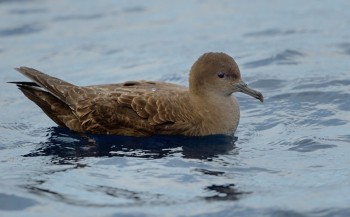
Short-tailed Shearwater at sea, photograph by Kirk Zufelt
Katherine Brownlie (School of Life and Environmental Sciences, Deakin University, Burwood, Australia) and colleagues have published in the journal Emu - Austral Ornithology on using acoustic loggers in Short-tailed Shearwaters Ardenna tenuirostris colonies to estimate breeding information.
The paper’s abstract follows:
“Establishing appropriate conservation management objectives and actions for seabirds requires timely detection of changes in their populations. However, obtaining regular accurate measures of seabird population size and trends can be difficult due to logistical and financial constraints in accessing remote breeding sites. The Short-tailed Shearwater (Ardenna tenuirostris) is a wide-ranging, burrow-nesting Procellariiform [sic] with an estimated breeding population size of ca 23 million individuals. Despite its ecological significance, there is currently limited monitoring of the species. In the present study, eight acoustic data loggers were deployed across six sites over two breeding seasons to assess the efficacy of acoustic monitoring. Five acoustic indices were used to investigate vocal activity over the breeding season, detect phenology events, and to determine the most accurate period to assess the density of occupied nests. The general pattern over the breeding season was similar for several of the acoustic indices and reflected colony attendance patterns. Linear regressions fitted to the normalised difference soundscape index values and density of occupied nests (burrows·m−2) revealed significant relationships in both the incubation and chick-rearing. The results suggest that passive acoustic monitoring could be used as an effective method to predict nesting density in Short-tailed Shearwater breeding colonies. Used in conjunction with information on the breeding colony area, this could enable regular estimates of colony population size. Such information is crucial for the early detection of population trajectory changes. The method may also be applicable for other burrow- or surface-nesting seabirds for which regular wide-spread monitoring currently proves difficult.”
Reference:
Brownlie, K.C., Monash, R., Geeson, J.J., Fort, J., Bustamante, P. & Arnould, J.P.Y. 2020. Developing a passive acoustic monitoring technique for Australia’s most numerous seabird, the Short-tailed Shearwater (Ardenna tenuirostris). Emu - Austral Ornithology, DOI: 10.1080/01584197.2020.1732828.

 English
English  Français
Français  Español
Español